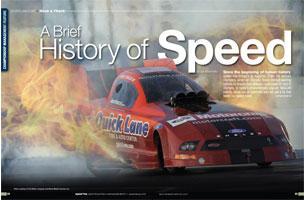
Since the beginning of human history, speed has brought us together. From the earliest Olympics, when an Olympic Truce calmed warring nations to ensure that athletes could travel to race in Olympia, to today's phenomenally popular NASCAR events, races are an essential way we get a fix that feeds our speed need.
Fleet Feet
The stadion race, a sprint of approximately 200 yards, was one of five Pentathlon sports at the ancient Olympic Games. Named for the facility where the event took place, this classic race laid the groundwork for many of our popular contemporary Olympic footraces, as well as the name for where we hold them: stadiums.
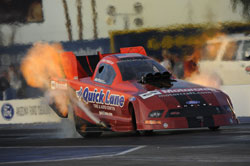 |
| Photo courtesy of Ford Motor Company and Wieck Media Services, Inc. |
Today's track events are much more numerous and varied, from the 50 meter sprint to the marathon, but they are no less popular. Track and field events are not only the world's oldest organized sports, they're also the most-watched of all the Olympic sports and the number one participatory sport for high school and college athletes. Even beyond that, 30 million American runners participate in thousands of amateur races annually.
But where track and field events are concerned, the pre-Olympic pinnacle is the USA Track & Field (USATF) U.S. Team Olympic trials, which, in 2008, returned to one of the sport's most revered locations, Oregon's Hayward Field.
"The last time we hosted Olympic trials was in 1980, so it's a truly amazing thing for us to get it back," said Janis Ross, vice president of Convention & Sports Marketing, Travel Lane County. "The 2008 trials really surpassed our imagination. Everyone got involved; fans packed the stands. People here know track and field and they love it. We're really reviving that legacy."
Historic Hayward Field continues giving new, vibrant life to that tradition, bringing back the Olympic Trials in 2012 and hosting the USA Outdoor Track and Field Championships in 2009 and 2011 and the NCAA National Track and Field Championships in 2010.
The Sport of Kings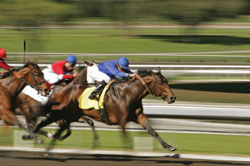 Another contender for the title of the world's oldest road and track sport is another sport with a rich history and a long pedigree: horse racing. Perhaps one of the earliest examples were the Roman chariot races; and today in America, the popular focus on horseracing centers mainly on Thoroughbred racing and revolves around the hallowed horseracing grounds at Kentucky's Churchill Downs. But while the Kentucky Derby holds a serious share of the country's imagination as the quintessential horseracing event, there are actually opportunities to take part in this classic event all across the country.
Another contender for the title of the world's oldest road and track sport is another sport with a rich history and a long pedigree: horse racing. Perhaps one of the earliest examples were the Roman chariot races; and today in America, the popular focus on horseracing centers mainly on Thoroughbred racing and revolves around the hallowed horseracing grounds at Kentucky's Churchill Downs. But while the Kentucky Derby holds a serious share of the country's imagination as the quintessential horseracing event, there are actually opportunities to take part in this classic event all across the country.
Horseracing can be found several times a week along the San Francisco Bay at Golden Gate Fields. Offering a one-mile dirt track and a .9-mile turf course, Golden Gate Fields can host more than 1,350 horses and 9,000 customers on any given day. The historical Fields hosted its first race in 1941, just before the start of World War II and was home to Lost in the Fog, one of horseracing's legends, a horse that received favoring odds in every single lifetime start.
While thoroughbred racing is perhaps the highest-profile of American horseracing events, steeplechase racing, a kind of horserace involving various obstacles that the horses have to jump, also has a strong following and a vibrant history. Unlike thoroughbred races, steeplechase races are done not on a circular course, but across a wooded course anywhere from one to several miles long. Also called hunt or timber races, steeple chasing has strong ties to its ancestor, Colonial and British fox hunting. The rolling green hills of Maryland are home to a serious steeplechase season to rival any of its more prestigious British cousins.
Maryland's top steeplechase event is the My Lady's Manor, an event that started, like all of these sports, with the need for speed. The race began in 1902 when a group of men on the Manor needed a gentlemanly way to determine who had the fastest and best jumper. Today the ancestors of some of those men still ride in the race, but as Maryland horse culture dictates, a whole new generation of riders, now including both genders of horse racers, gets involved every year. It's a classic way to get a healthy dose of speed, history and culture all at once.
Velocipedia
Velocipede may sound like a Latin term for a speedy insect, but actually it comes from the Latin for "fast foot" and refers to any one of the one-to-several-wheeled vehicles - the most common being the bicycle - that so many athletes and spectators depend on to satisfy their passion for rapidity. In Bakersfield, California, bicycles and bicycle races are so popular that they almost seem commonplace, but in 2010, a race is coming to this California town that is nothing close to commonplace.
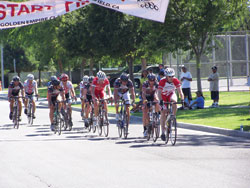 |
| 2008 Criterion hosted by Bike Bakersfield - Photos courtesy of Bakersfield CVB |
The 16-stage Amgen Tour of California, in its fifth year in 2010, will take place May 16 -20, 2010, and Bakersfield will be the triumphant host of the race's 5th stop.
"We can provide the race with an incredibly thrilling stage finish, and I would predict our finish might be the most exciting of all eight," says Don Cohen, manager, Bakersfield Convention and Visitors Bureau. The finish will be at Bakersfield College. Riders will come out of the mountains on a steep incline, turn around and finish on this bluff that words just can't describe. It will be a challenge finish the racers will enjoy and provide excellent views of the riders. Spectators will just be amazed by it."
The Amgen tour is just one of the ways cycling is celebrated in Bakersfield. The community hosts a range of cycling events, all the way from elite to recreational.
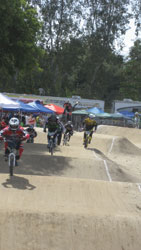 |
| 2009 ABA U.S. Nationals event at Metro BMX in Bakersfield |
"We just hosted the 5th Annual Hart Park Cyclocross, part of the Southern California Prestige Series, an annual triathlon that draws around 1,000 people, and we have a Spooktacular Century (100 mile) each October," says Kerry Ryan, president of the Bakersfield Sports Foundation and owner of Action Sports, a local sporting goods leader and organizer of many of the community's sports events. "But it goes way beyond competitive events. We have all kinds of leisure rides too."
And while many of Bakersfield's citizens are avid cyclists, it's not just the local community that supports this wide variety of cycling events. Around half of the attendance at each of the area's events is actually from out of town, including 40 percent of leisure riders who come from all over the region to ride Bakersfield's bike paths, surrounded by picturesque mountains on three sides.
And while Bakersfield is home to athletic facilities and events of all kinds, one of their most historic, the historic Auto Club Famoso Raceway, offers a window into a classic American speed sport: drag racing.
Extreme Motorsports
Four hours east of Bakersfield is the Mojave Desert, the birthplace, in the 1930s, of hot rodding, according to the sport's anchor organization, the National Hot Rod Association (NHRA). "Hot rod" is a term that applies to any car modified for speed, and drag racing is the sport of testing exactly how much speed hot rodders can achieve.
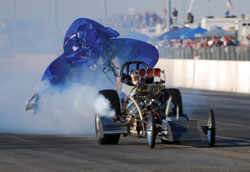 |
| California Hot Rod Reunion at Auto Club Famoso Raceway in Bakersfield - Photo courtesy of Bakersfield CVB |
As drag racing became more popular, it also started to become more organized. The first drag strip - the Santa Ana Drag Strip - started in the 1950s on what is now Orange County's John Wayne Airport. At about the same time, the NHRA got its start, created by drag racing pioneer Wally Parks to "create order from chaos" by establishing rules for safety and performance that would legitimize the sport.
In the next decade, drag strips blossomed all across the United States - places that would keep hot rodders off the streets and on legal drag strips - which was the primary mission of the NHRA. Bakersfield's Auto Club Famoso Raceway, founded in 1954, is one of those strips.
"The Bakersfield Smokers - named for their tire smoke - founded the Auto Club Famoso on a World War II airstrip that was originally built as a landing strip for delivering ammunition to a nearby storage facility," explains Blake Bowser, vice president and general manager, Auto Club Famoso Raceway. "We were really put on the map in 1959 with the very first March Meet, a nationwide drag race, and Bakersfield became known as the hot place to race."
The March Meet, now a nostalgia race, continues today, packing hotels and restaurants and bringing an estimated $12 million to the community with each three-day meet. Auto Club Famoso also offers a full racing season from mid-February through mid-November, with Friday night races open to the public, and not just as spectators.
"We invite anyone in the public to bring a street car or purpose-built drag car out here every other Friday to race," says Bowser. "Just like in the beginning of drag racing, it helps with the problem with street racing if people have a great place to race."
Despite the popularity among racing enthusiasts, Bowser explains that the tremendous expense of raceway operating is driving many drag strips out of business. But Auto Club Famoso has its own plan for perpetuating the sport.
"If we don't have the chance to expose the sport to the younger generation, we have no chance," says Bowser. "That's why we host a junior and high school drag series, which is really popular. Public access is also very important. You've got to make it affordable."
Drag racing may have been born in the West, but its popularity flared quickly across the U.S., as has enthusiasm for racing in all its forms. Chicagoland Speedway in Joliet, Illinois, is one of the Midwest's leading raceways.
"We're fortunate to have incredible racing in Joliet. Chicagoland Speedway offers facilities for NASCAR, Automobile Racing Club of America (ARCA), Indy Racing League (IRL), and also drag racing," says Ben Benson, executive director, Joliet Visitors Bureau. "And just down the street is the Autobahn Country Club, a premier racing country club located on 350 acres of woodlands."
With two distinct circuits, a 1.5-mile North Circuit and a 2.2-mile South Circuit, when combined, the Autobahn's courses create the fourth largest road racing circuit in the U.S. The Autobahn Country Club also offers public rental karting on a half-mile track and rents its facility for team building and corporate events.
NASCAR and its stock car racing dynasty have its roots in the south, but the coasts of the Southeast have another racing passion: historic cars. The Hilton Head Island Concours d'Elegance and Motoring Festival is a four-day event, starting with the Savannah/Hilton Head Speed Classic. Hosted at the newly reopened Hutchinson Island track, the Classic offers two days of vintage track events, including vintage racing.
‘The Hutchinson Island track is right across the river from downtown Savannah," says Benjamin Wilder, director, Greater Savannah Sports Council. "It sat dormant until two years ago, but when the Hilton Head event wanted to bring the racing portion of its weekend here, we were thrilled. Now we're in talks to bring some other racing events to the area."
After two days of racing, which in 2009 included a special series of vintage Porsche races, the official Concours d'Elegance competition day begins on the first Sunday of November, featuring a competition of over 150 vintage cars and motorcycles.
New Ways to Fly
Even before we had any kind of vehicle,humans used their bodies in every way possible to experience the freedom and exhilaration of speed. And while road and track sports are some of the most invigorating speed sports around, if you've truly got the guts for a little velocity, there are athletic events all across the country that can accommodate that desire. To find your fix, all it takes is a little curiosity, a sense of adventure and an Internet connection... preferably a fast one.

